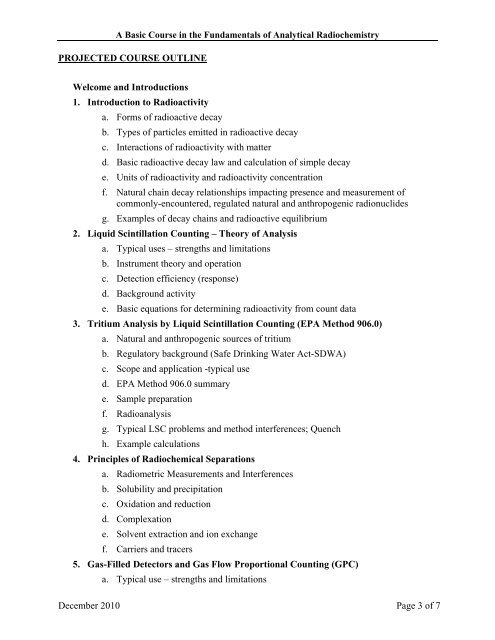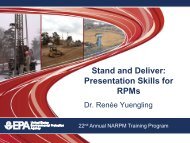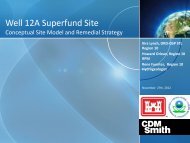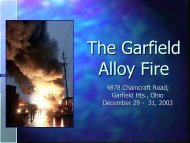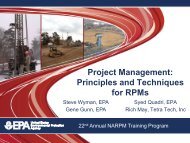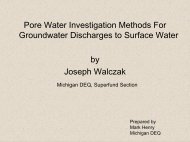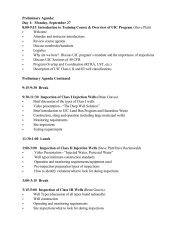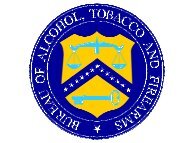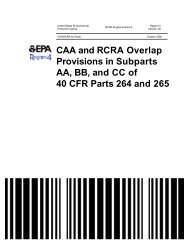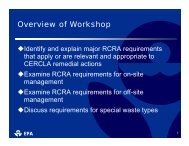About <strong>the</strong> Instructors:A <strong>Basic</strong> <strong>Course</strong> <strong>in</strong> <strong>the</strong> <strong>Fundamentals</strong> <strong>of</strong> <strong>Analytical</strong> <strong>Radiochemistry</strong>Anna Berne, Ph.D. is a nationally recognized expert <strong>in</strong> radiochemistry and radioanalytical methods,particularly <strong>in</strong> <strong>the</strong> field <strong>of</strong> radiochemical analysis <strong>of</strong> low-level environmental materials, with additional<strong>in</strong>terest <strong>in</strong> generat<strong>in</strong>g data <strong>of</strong> known and appropriate quality. Dur<strong>in</strong>g her 16 years at <strong>the</strong> EnvironmentalMeasurements Laboratory, she ga<strong>in</strong>ed expertise on an <strong>in</strong>ternational scale <strong>in</strong> <strong>the</strong> field <strong>of</strong> radiochemicalanalysis <strong>of</strong> low-level environmental materials, with additional <strong>in</strong>terest <strong>in</strong> generat<strong>in</strong>g data <strong>of</strong> known andappropriate quality. She has been responsible for radiochemical analysis <strong>of</strong> <strong>the</strong> Quality AssessmentProgram (QAP) Performance Evaluation (PE) samples, as well as analysis <strong>of</strong> samples for o<strong>the</strong>r nationaland <strong>in</strong>ternational programs, such as <strong>the</strong> Radiological Traceability Program (RTP, sponsored by <strong>the</strong>Department <strong>of</strong> Energy and <strong>the</strong> National Institute for Standards and Technology) and <strong>the</strong> InternationalAtomic Energy Agency <strong>in</strong>tercomparison programs. She has also been <strong>in</strong>volved <strong>in</strong> develop<strong>in</strong>g new radioanalyticalmethods at EML and presented <strong>the</strong> results <strong>of</strong> her work at national and <strong>in</strong>ternational meet<strong>in</strong>gsand conferences, such <strong>the</strong> annual Conference on Bioassay, <strong>Analytical</strong>, and Environmental<strong>Radiochemistry</strong> (BAER, currently called RRMC), <strong>the</strong> International Conference on Methods andApplications <strong>of</strong> Radioanalytical Chemistry (MARC) and The International Conference on RadionuclideMetrology and its Applications (ICRM). Dr. Berne is an active member <strong>in</strong> <strong>the</strong> ASTM Committee D19.Robert Litman, Ph.D. has been a researcher and practitioner <strong>of</strong> nuclear and radiochemical analysis for<strong>the</strong> past 34 years. He is well respected <strong>in</strong> <strong>the</strong> nuclear power <strong>in</strong>dustry as a specialist <strong>in</strong> radiochemistry andradiochemical <strong>in</strong>strumentation and plant systems corrosion. He authored <strong>the</strong> section <strong>of</strong> <strong>the</strong> EPRI PWRPrimary Water Chemistry Guidel<strong>in</strong>es on Radionuclides and has been a significant contributor to EPRIPrimary-to-Secondary Leak Detection Guidel<strong>in</strong>es. For <strong>the</strong> past four years, he has been <strong>the</strong> radiochemicalspecialist at <strong>the</strong> decommission<strong>in</strong>g <strong>of</strong> <strong>the</strong> Yankee Rowe Nuclear Power Station for water and soilanalytical sampl<strong>in</strong>g and analysis. He has co-authored two chapters <strong>of</strong> MARLAP, and is currently one <strong>of</strong> ateam <strong>of</strong> specialists present<strong>in</strong>g MARLAP tra<strong>in</strong><strong>in</strong>g. His areas <strong>of</strong> technical expertise are gammaspectroscopy and radiochemical separations. Dr. Litman has been teach<strong>in</strong>g courses <strong>in</strong> <strong>Radiochemistry</strong>and related special areas for <strong>the</strong> past 18 years.Robert Shannon is recognized as a national expert <strong>in</strong> environmental radiochemistry and radiobioassay,radioanalytical laboratory management and QA/QC, and method, laboratory and <strong>in</strong>formation systemsdevelopment. His <strong>in</strong>timate familiarity with <strong>the</strong> methods, techniques and protocols <strong>of</strong> environmentalradiochemistry stems from years <strong>of</strong> applied laboratory experience. He has served as technical directorand radiochemistry manager with several commercial laboratories, as deputy manager <strong>of</strong> <strong>the</strong> on-sitelaboratories, and <strong>Radiochemistry</strong> and Radiobioassay Subject Matter Expert at <strong>the</strong> Rocky FlatsEnvironmental Technology Site, CO and is a radiochemistry auditor with <strong>the</strong> Department <strong>of</strong> EnergyConsolidated Audit Program (DOECAP). Mr. Shannon contributes extensively to methods, standards andQA system development activities with ASTM Committees D19 and C26, Standard Methods for <strong>the</strong>Exam<strong>in</strong>ation <strong>of</strong> Water and Wastewater and is a member <strong>of</strong> <strong>the</strong> Health Physics Society and <strong>the</strong> AmericanChemical Society. In 2003, he received <strong>the</strong> RRM/BAER (Radiobioassay & Radiochemical Measurements/Bioassay,<strong>Analytical</strong>, and Environmental <strong>Radiochemistry</strong> Conference) Conference FoundersAward.December 2010 Page 2 <strong>of</strong> 7
A <strong>Basic</strong> <strong>Course</strong> <strong>in</strong> <strong>the</strong> <strong>Fundamentals</strong> <strong>of</strong> <strong>Analytical</strong> <strong>Radiochemistry</strong>PROJECTED COURSE OUTLINEWelcome and Introductions1. Introduction to Radioactivitya. Forms <strong>of</strong> radioactive decayb. Types <strong>of</strong> particles emitted <strong>in</strong> radioactive decayc. Interactions <strong>of</strong> radioactivity with matterd. <strong>Basic</strong> radioactive decay law and calculation <strong>of</strong> simple decaye. Units <strong>of</strong> radioactivity and radioactivity concentrationf. Natural cha<strong>in</strong> decay relationships impact<strong>in</strong>g presence and measurement <strong>of</strong>commonly-encountered, regulated natural and anthropogenic radionuclidesg. Examples <strong>of</strong> decay cha<strong>in</strong>s and radioactive equilibrium2. Liquid Sc<strong>in</strong>tillation Count<strong>in</strong>g – Theory <strong>of</strong> Analysisa. Typical uses – strengths and limitationsb. Instrument <strong>the</strong>ory and operationc. Detection efficiency (response)d. Background activitye. <strong>Basic</strong> equations for determ<strong>in</strong><strong>in</strong>g radioactivity from count data3. Tritium Analysis by Liquid Sc<strong>in</strong>tillation Count<strong>in</strong>g (EPA Method 906.0)a. Natural and anthropogenic sources <strong>of</strong> tritiumb. Regulatory background (Safe Dr<strong>in</strong>k<strong>in</strong>g Water Act-SDWA)c. Scope and application -typical used. EPA Method 906.0 summarye. Sample preparationf. Radioanalysisg. Typical LSC problems and method <strong>in</strong>terferences; Quenchh. Example calculations4. Pr<strong>in</strong>ciples <strong>of</strong> Radiochemical Separationsa. Radiometric Measurements and Interferencesb. Solubility and precipitationc. Oxidation and reductiond. Complexatione. Solvent extraction and ion exchangef. Carriers and tracers5. Gas-Filled Detectors and Gas Flow Proportional Count<strong>in</strong>g (GPC)a. Typical use – strengths and limitationsDecember 2010 Page 3 <strong>of</strong> 7


